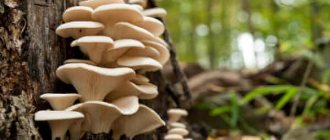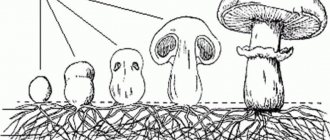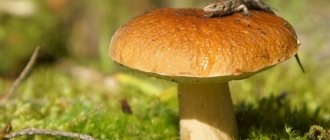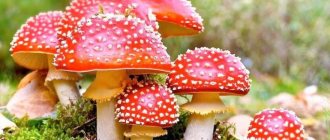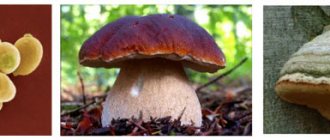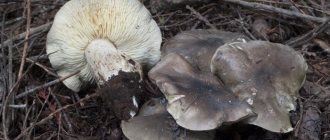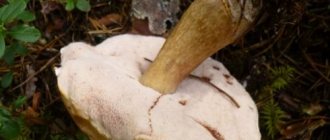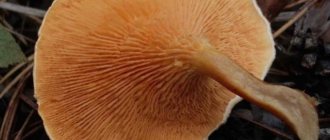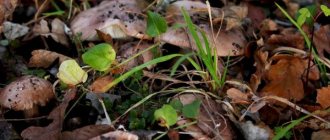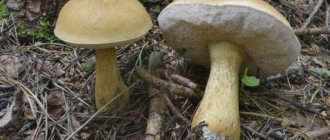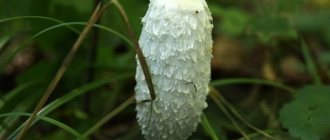Mushrooms
0
1454
Article rating
Kira Stoletova
For a mushroom picker, you need to know the structure of mushrooms. This will help distinguish edible species from inedible ones. The fruiting body of the fungus is formed by intertwining mycelial hyphae - thin threads tightly adjacent to each other. In the specialized part, spores are formed as a result of the sexual process. Has different sizes and shapes.
Mushroom fruiting body
What is the fruiting body of a mushroom
The main reproductive part of mushrooms is represented by the fruiting body. In scientific articles it is referred to as "sporocarp" or "carpophorus".
To reproduce, fungi need a fruiting body, which is formed from intertwined hyphae. This is how the pulp is formed, which makes up the bulk of the body of the mushroom. Spores form in the tissues of the fungus.
In order to examine them, the mushroom cap must be placed on a white piece of paper. A grayish coating forms on its surface. This is what they are.
Once in the soil, the spores germinate. In their place, a mycelium is first formed, on which mushrooms will later appear.
Inside and outside
What is the largest living organism on our planet?
Elephant? Blue whale? No, the largest organism on Earth is the honey fungus, growing in the American state of Michigan, living for two and a half thousand years and weighing about 400 tons. How can this be? It’s very simple - after all, most of the mushroom is underground - this is its real “body”, which is called mycelium, or mycelium, and those objects that we see on the surface of the earth or other substrate and, out of habit, call “mushrooms” are just the external organ of reproduction of the mycelium, which is called the “fruiting body”. The mycelium of one mushroom can reach gigantic sizes and spread underground over vast distances, which is why mushrooms are the largest living organisms on Earth. This article talks about the familiar external part of the mushroom - its fruiting body.
Mushrooms forming fruiting bodies
Fungi are higher and lower organisms. This classification is based on the structure of the mycelium. Lower fungi are characterized by mycelium without partitions and hyphae. Prominent examples of these are mucor, ringworm and late blight.
For higher fungi, a characteristic feature is the mycelium, which is separated by partitions from the fruiting bodies. The highest are yeast, penicillium, ergot, and cap mushrooms.
Mushroom propagation
Fungi can reproduce asexually, sexually and vegetatively.
The vegetative method is characterized by the division of the mycelium into several sections. Each one will grow into a new mushroom in the future .
Asexual reproduction is characterized by sporulation, during which spores are formed on hyphae or conidiophores (branching at the ends of hyphae). As soon as the spores enter an environment favorable for development, they begin to germinate and become the basis for a new mycelium.
Sexual reproduction occurs through the formation of germ cells (sperm and eggs) in antheridia and oogonia. As soon as a zygote is formed, a reduction process occurs in many fungi. Division occurs through meiosis. The cells that are formed receive a haploid chromosome set.
For marsupial fungi, the fruiting bodies are characterized by the appearance of asci (special bags), in which haploid spores develop. They grow into mycelium. After this, sperm cells are formed from antheridia (male genital organs), and eggs are formed from ovognia (female genital organs). After their interaction, a diploid cell (zygote) is obtained. It, in turn, divides into 8 ascospores using meiosis.
Basidiomycete fungi do not have pouches. These include fly agarics, boletus mushrooms, boletus mushrooms, champignons, russula, honey mushrooms, saffron milk caps and chanterelles. They reproduce using basidospores, which are located directly on the basidia. The fusion of these cells is called “somatogamy,” that is, the process of vegetative reproduction of two mycelial cells.
Yeast also deserves special attention. They reproduce by budding. In this case, a thickening appears on the cell. It develops, and over time a daughter plant grows from it.
Literature
Popular publications:
- Grunert G.
Mushrooms / trans. with him. - M.: “Astrel”, “AST”, 2001. - P. 10-11. — (Guide to Nature). — ISBN 5-17-006175-7. - Vavrish P. O., Gorovoy L. F.
Mushrooms in the forest and on the table. - K.: "Harvest", 1993. - P. 36-39. — ISBN 5-337-00728-9. - Lesso T.
Mushrooms, key / trans. from English L. V. Garibova, S. N. Lekomtseva. - M.: “Astrel”, “AST”, 2003. - P. 10-13. — ISBN 5-17-020333-0.
Scientific and educational publications:
- Müller E., Löffler V.
Mycology / trans. with him. K. L. Tarasova. - M.: "Mir", 1995. - P. 269-274. — ISBN 5-03-002999-0. - Kutafieva N.P.
Morphology of fungi. - Krasnoyarsk: "IC KrasGU", 1999. - ISBN 5-7638-0161-X. - Zmitrovich I.V.
Epimorphology and tectomorphology of higher fungi / ed. S. P. Vassera. - St. Petersburg, 2010. - (Folia Cryptogamica Petropolitana. 2010. No. 5.). ISSN 1810-9586
The structure of the fruiting body of a mushroom
The most common mushrooms are cap mushrooms. From them you can very clearly see the structure of the fruiting body.
Hat . The main part of their fruiting body is the cap, on which the spore-bearing layer (hymenophore) is located. In shape it can be: spherical, hemispherical, ovoid, bell-shaped, conical (with a tubercle in the center), concave, convex and spread.
By the shape of the cap, you can determine the type and age of the mushrooms. The skin on the cap has a protective function. And the older the fungus, the more exposure it is exposed to the external environment.
The pulp of the mushroom is formed due to the growth of sterile hyphae. It may have a woody, cartilaginous or fleshy structure. The organoleptic characteristics and consistency of the pulp are very different. Some types of mushrooms secrete a kind of milky juice.
The hymenophore is the spore-bearing layer of the cap, which is the main element for which the fruiting body of mushrooms functions. In its structure, the genophenophore can be folded, spinous, tubular, and also in the form of a labyrinth or plate. The last type is most common for cap species.
The hymenophore contains spores. Once ripe, he throws them out. Disputes are characterized by high resistance to external influences. They are spread by wind and animals.
Usually the hymenophore is located at the bottom of the cap, but there are exceptions when it is on top (for example, in morels) or inside the cap (as in puffballs). For mushrooms with a non-standard shape, the hymenophore is located in the safest area of the body.
During the development stage, the spores are under a protective membrane. As soon as the ripening process reaches its end, it breaks and falls down, forming a ring of film on the stem. And on the cap itself there are pieces in the form of scales. This is how white peas appear on the red cap of the fly agaric.
Leg . The supporting part of the fruiting body is the stalk. It is shaped like a cylinder and in some species has a slight expansion at the top or bottom. The lower section is immersed in the soil, leaf or woody base. At its base there is mycelium. It can be attached to the cap in several ways (central, lateral and eccentric). They can also be attached tightly to each other or be easily separated.
The pulp inside the stem of mushrooms may not always be suitable for consumption. The older the mushroom, the tougher the pulp becomes.
The inner part of the stem can be either solid or with voids that form as the mushroom grows. The surface texture of the stalk can be rough, smooth, slimy or dry.
The basic Instinct
The only purpose for which the mycelium grows a fruiting body above the surface of the substrate is reproduction. Yes, the mycelium grows on its own, and, as already mentioned, it can, during gradual growth, spread over vast distances, but this process occurs slowly and is very limited geographically - in a couple of hundred years of growth, you can grow tens of kilometers to the side, however, there is a convenient way to send your DNA there right away. This method - spores - are microscopic and weightless seeds, the purpose of which is to grow and distribute the fruiting body. Ripe spores are so light that they are easily carried in all directions by the wind, cling to the legs of insects, the fur of forest animals, the clothes of people passing by, and can be carried away by them to a great distance from their place of birth. Science knows many stories when fungal spores crossed the world's oceans, for example, getting into tubs of soil for transporting selected tree species, and germinated, appearing in those parts of the world where this type of mushroom had never grown before.
The fruiting bodies of numerous species of mushrooms honorably fulfill their task - they grow from the mycelium, store and bring spores to maturity, and then throw them out into the outside world to find a suitable place for germination.
Mushroom fruiting body plates
On the surface of the cap there are outgrowths that are located radially from the stem or from the attachment to the place of growth of the sessile caps. The main characteristics of the plates include thickness and method of attachment to the mushroom stem. Many mushrooms are characterized by the presence of plates of different sizes:
– with normal length (up to the stem);
– with a shortened long one (does not reach the leg);
- the shortest records.
Some mushrooms have a small ring (collar) that is located around the stem. And the plates themselves grow from it. It is also possible that there may be some branching or the presence of bridges between the plates and the mushroom. The types of mushrooms are recognized by their location and length.
Main characteristics of mushroom plates:
- Depending on the nature of the arrangement of the plates, they are divided into rare, very rare, frequent and very frequent.
- According to external signs, they are thick and thin.
- Depending on the shape, the plates can be triangular, crescent-shaped or convex.
- They can be monochromatic in color or with multi-colored spots. With age, the color changes.
- Based on the nature of the edges of the plate, they are distinguished as solid, wavy, jagged, serrated or even.
Characteristic signs.
Also on topic:
PLANT SYSTEMATICS
Fungi are a large and ubiquitous group of highly diverse organisms that can exist in a wide range of conditions. The science that studies them is called mycology, and specialists in this field are called mycologists. Once upon a time, fungi were included in the plant kingdom and, together with bacteria, algae and lichens, constituted a department of lower, layered, or thallus, plants (Thallophyta). As these four groups were studied further, they were all distributed into other kingdoms, and the previous classification was considered obsolete.
Mushrooms are quite different from plants. First of all, they are deprived of chlorophyll - a green pigment characteristic of plants, necessary for photosynthesis, i.e. the formation of nutrient organic substances (carbohydrates) from minerals (carbon dioxide and water) with the accompanying release of oxygen. Consequently, fungi, like animals, feed not autotrophically, but heterotrophically - ready-made organic matter from external sources. To do this, they either parasitize living organisms (including other fungi) or consume their dead remains and waste products (for example, plant nectar); in the latter case they are called saprotrophs. Some fungi form highly specialized symbiotic associations with algae (lichens) or plant roots (mycorrhizae).
The unique characteristics of fungi justify their separation into the independent kingdom Mycetae or Fungi. Now many mycologists believe that the organisms included in it are too diverse, and some groups traditionally classified as fungi are transferred to other kingdoms. In particular, slime molds (Myxomycota), with their characteristic amoeboid feeding stage, are increasingly considered as part of the kingdom of protista (Protista).
Shapes of the fruiting body of the mushroom
In scientific sources, depending on the shape, mushrooms are:
– sessile (hoof-shaped, cantilever-shaped and irregular);
– hat-footed;
– rounded (spherical, pear-shaped, tuberous, etc.);
– and others.
This division cannot be accurate and scientifically confirmed. But it is very convenient to recognize them during assembly. Many mushrooms change a lot as they grow. For example, rounded fruiting bodies can transform into a star shape.
Fruit fungus development
The environment is an important factor influencing the development of the fruiting body of the fungus. The main parameters are temperature and humidity. The bulk of mushrooms bear fruit at average summer temperatures and high humidity.
Fruiting bodies produce millions (in some cases billions) of spores. As soon as they ripen, they begin to be ejected from the body of the fungus. With the help of wind and animals, they fly over long distances (up to hundreds of kilometers).
As soon as the spores enter an environment with favorable conditions, they begin to germinate and form hyphae, which branch and elongate. Thus, mycelium is formed, which grows through the substrate. The mycelium threads grow and absorb all the beneficial components of the soil. At one of the stages of development, the mycelium begins to bear fruit. This happens in the following way: the mycelial hyphae begin to intertwine, and at the places where they accumulate, a nodule is formed, from which the fruiting body of the fungus soon grows. Next, the mushroom receives moisture and everything necessary for development from the mycelium.
Boletus fruiting body
The fruiting body of the boletus has the following parts:
- hat;
- leg;
- roots;
- shoots.
The diameter of a ripe mushroom cap can be a maximum of 18 cm. The color of the cap is from light gray to brown, sometimes with a brownish tint.
The stem of the mushroom is scaly, reminiscent of tree bark, with a height of about 15-17 cm and a diameter of up to 3 cm. The stem has a wide base with a slight narrowing towards the top. In young mushrooms, the stem is barrel-shaped, while in mature boletus mushrooms it has a wide base with a narrowed top.
Notes
- Müller, Löffler, 1995, p. 269.
- Reijnders AFM
The histogenesis of bulb- and trama tissue of the higher Basidiomycetes and its phylogenetic implications // Persoonia. - 1977. - Vol. 9. - P. 329-361. - Clémençon H.
Anatomie der Hymenomyceten. - Teufen: Komissionsverlag F. Flück-Wirth, 1997. - ISBN 3-7150-0040-6. - Clémençon H.
Cytology and Plectology of the Hymenomycetes / with assistance of V. Emmett and E. E. Emmett. - 2004. - (Bibliotheca Mycologica. Vol. 199). — ISBN 3-443-59101-9. - Zmitrovich, 2010, p. 211.
